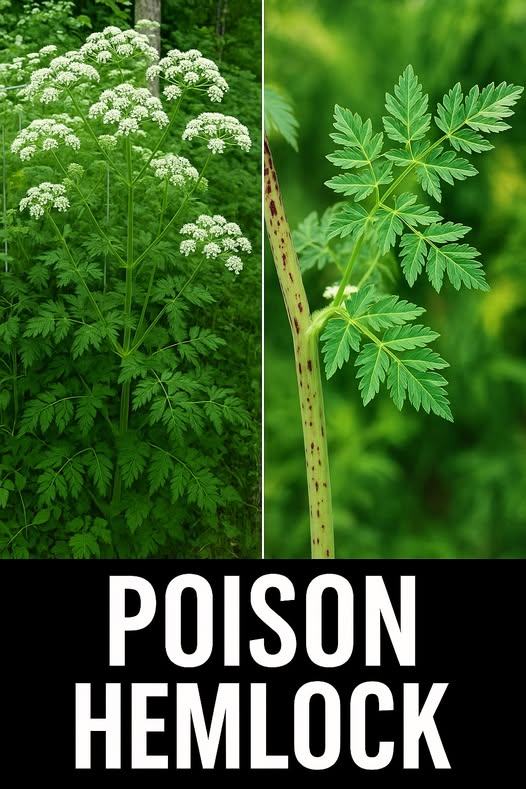Poison Hemlock Warning: How to Identify This Extremely Toxic Plant Before It’s Too Late
As the landscape bursts into green after a wet spring, so too do some of nature’s most dangerous plants—and Poison Hemlock is at the top of the list. This highly toxic plant is currently thriving across fields, roadsides, and ditches, thanks to the unusually wet weather conditions. While its delicate white flowers might seem harmless or even beautiful, Poison Hemlock is far more dangerous than poison ivy—some say up to 100 times more toxic.
Whether you’re a gardener, hiker, farmer, pet owner, or parent, knowing how to identify Poison Hemlock can protect you and your loved ones from serious harm. This plant isn’t just irritating—it’s potentially fatal.
⚠️ Why Poison Hemlock Is So Dangerous
Poison Hemlock (Conium maculatum) contains toxic alkaloids, including coniine, which disrupt the nervous system. Even small amounts can be lethal if ingested by humans or animals. It can cause:
- Respiratory failure
- Muscle paralysis
- Nausea and vomiting
- Seizures
- Death in severe cases
Skin contact may not always result in symptoms, but plant sap can be absorbed through cuts, and inhalation of sap particles (during mowing or pulling) has also been linked to serious reactions.
🌼 Don’t Be Fooled by the Pretty Flowers
During late spring and early summer, Poison Hemlock becomes much more visible, blooming with umbrella-shaped clusters of tiny white flowers that look similar to Queen Anne’s Lace or wild carrots.
But unlike those harmless look-alikes, Poison Hemlock is deadly.
✅ How to Identify Poison Hemlock – Key Features
Here are the critical features to help you spot and avoid this toxic plant:
🔍 1. Purple Splotches on the Stem
- This is the number one identifier.
- The tall, hollow stems (2 to 10 feet high) have irregular purple or reddish blotches.
- The stem is not hairy (unlike Queen Anne’s Lace).
🔍 2. Fern-like Leaves
- The leaves are finely divided, resembling parsley or carrot greens.
- They are bright green and very delicate in texture.
🔍 3. White Flower Clusters
- Blooms in umbrella-shaped clusters, similar to other members of the carrot family.
- Each cluster contains dozens of small, five-petaled white flowers.
🔍 4. Height and Structure
- Mature plants can grow up to 10 feet tall.
- The plant is branching, with a large taproot and robust structure.
🔍 5. Location
- Often found in wet areas, such as:
- Ditches
- Riverbanks
- Roadsides
- Abandoned fields
- Open meadows
🚫 Do Not Touch or Handle This Plant
- Never pull Poison Hemlock with bare hands.
- Wear gloves, long sleeves, and eye protection if removal is absolutely necessary.
- Do not mow or burn it, as this may release toxic particles into the air.
If exposed:
- Wash skin immediately with soap and water.
- If inhaled or ingested, seek emergency medical attention immediately.
🐶 Pet and Livestock Warning
Poison Hemlock is extremely toxic to animals, including:
- Dogs
- Cats
- Horses
- Cattle
- Goats and sheep
Symptoms in animals include trembling, salivation, difficulty breathing, and sudden death. Ensure pets and livestock are kept away from infested fields.
🌱 What to Do If You Find Poison Hemlock on Your Property
- Confirm Identification – Look for purple-streaked, hairless stems and fern-like leaves.
- Avoid Mowing or Weed-Whacking – These can spread the plant’s seeds or toxic sap.
- Manually Remove (With Caution) – Uproot small patches wearing protective clothing.
- Dispose of Properly – Place in sealed garbage bags. Do not compost or burn.
- Follow Up – Monitor the area regularly; Hemlock spreads aggressively and can return the following year.
🌼 Other Look-Alike Plants (That Are NOT Toxic)
To avoid confusion, here are some similar-looking plants that are generally safe:
- Queen Anne’s Lace (Wild Carrot) – Hairy stem, single purple dot in flower center.
- Cow Parsnip – Large white flower clusters, thick ridged stem, often hairy.
- Yarrow – White or pink flowers in tight clusters, soft feathery leaves.
Key difference? None of these have purple blotches on the stem like Poison Hemlock.
🧠 Fast Facts – Poison Hemlock at a Glance
| Feature | Description |
|---|---|
| Stem | Hollow, hairless, purple blotches |
| Leaves | Fern-like, parsley-shaped |
| Flowers | White, umbrella-shaped clusters |
| Height | Up to 10 feet |
| Location | Moist areas, disturbed land |
| Toxicity | Extremely high – deadly if ingested |
🛑 Take This Seriously
Even brushing against Poison Hemlock unknowingly can be risky. It’s especially important to educate children, pet owners, and gardeners about the dangers and appearance of this plant.
🗣️ Spread the Word, Not the Plant
If you’ve spotted Poison Hemlock in your area:
- Report infestations to your local agricultural or environmental authorities.
- Educate neighbors and community groups.
- Share photos on social media with safety warnings to raise awareness.
✅ Stay Safe This Spring and Summer
With the recent wet weather, the growth of Poison Hemlock is accelerating—so stay alert. When you’re enjoying the outdoors, gardening, or walking your pets, take a moment to scan for signs of this plant.
If you see white flowers and purple-streaked stems, steer clear.
